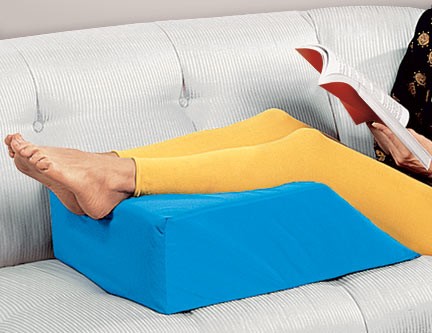Elevation
 Elevation can be important in reducing swelling and pain. It is known to decrease the amount of blood flow to the knee and also reduce the amount of lymph and tissue fluid in the damaged area. This reduces the amount of inflammation and relieves the pressure. To properly elevate the knee and receive the best results, it is important to keep the foot above the hip (not the heart) and the higher the elevation of the knee, the better. If you are lying on the floor, bed, or couch facing upwards, the catchy rule “toes above nose” is a useful guideline; this is referencing the fact that if your body is resting on a level surface like a cushion, pillow, or other comfortable assistive device, you should try to keep the toes a little above eye level. Never elevate the knee/leg in a bent position (like a 90-degree angle), but a little bit of an angle is perfectly fine, especially if it is painful for your knee to keep the leg fully extended. Some people believe that simply raising the leg up on a stool or slightly on a reclining chair is proper elevation; however, it is less effective than properly lifting the knee and resting it in place. Never place a lot of pillows or cushion directly under the calf, as this can create unwanted compression and have undesirable effects in the calf area. Elevation, when performed the right way, can be greatly effective for reducing the amount of pain you experience in the knee.
Elevation can be important in reducing swelling and pain. It is known to decrease the amount of blood flow to the knee and also reduce the amount of lymph and tissue fluid in the damaged area. This reduces the amount of inflammation and relieves the pressure. To properly elevate the knee and receive the best results, it is important to keep the foot above the hip (not the heart) and the higher the elevation of the knee, the better. If you are lying on the floor, bed, or couch facing upwards, the catchy rule “toes above nose” is a useful guideline; this is referencing the fact that if your body is resting on a level surface like a cushion, pillow, or other comfortable assistive device, you should try to keep the toes a little above eye level. Never elevate the knee/leg in a bent position (like a 90-degree angle), but a little bit of an angle is perfectly fine, especially if it is painful for your knee to keep the leg fully extended. Some people believe that simply raising the leg up on a stool or slightly on a reclining chair is proper elevation; however, it is less effective than properly lifting the knee and resting it in place. Never place a lot of pillows or cushion directly under the calf, as this can create unwanted compression and have undesirable effects in the calf area. Elevation, when performed the right way, can be greatly effective for reducing the amount of pain you experience in the knee.

